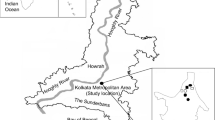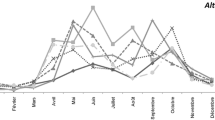Abstract
Fungal spores have a recognized allergenicity, but in recent years, fungal fragments have also been reported as inducers of Type I allergy. However, airborne hyphae are scarcely studied in tropical regions. The objective of this research was to analyze the fungal composition of the Havana aerosol during 2017 and 2018, emphasizing the presence of hyphae fragments. Air sampling was performed using a Lanzoni VPPS-2000 sampler. The fungal propagules collected were identified and counted following the recommendations of the Spanish Aerobiology Network in two longitudinal transepts of each daily slides. In 2017, the spore count and hyphae count were higher than in 2018 (108,607 spores and 3822 fungal fragments vs. 40,896 spores and 2268 fungal fragments). Cladosporium was the most abundant spore (77.2–76.6%), predominating in the month of May. Leptosphaeria ascospores were identified at lower levels (16.2–17.9%) but also abundant during May. The behavior of the hyphal fragments does not show great variations throughout the year. The contribution of this component to the aerosol ranged between 3.4 and 5.3% in 2017 and 2018, respectively. The intradiurnal periodicity showed a diurnal pattern for Cladosporium and nocturnal for Leptosphaeria, while the hyphae pattern does not show great variations. The temperature and relative humidity correlated with the concentration of the detected airborne fungi propagules. The composition of the fungal aerosol in Havana during the 2 years was characterized, including both spores and hyphal fragments, since both structures can be related to respiratory allergy pathologies.



Similar content being viewed by others
References
Afanou, K. A., Eduard, W., Laier Johnsen, H. B., & Straumfors, A. (2018). Fungal fragments and fungal aerosol composition in sawmills. Annals of Work Exposures and Health, 62(5), 559–570.
Almaguer, M., Aira, M. J., Rodríguez-Rajo, F. J., Fernández-González, M., & Rojas-Flores, T. I. (2015). Thirty-four identifiable airborne fungal spores in Havana, Cuba. Annals of Agricultural and Environmental Medicine, 22(2), 215–220.
Almaguer, M., Aira, M. J., Rodríguez-Rajo, F. J., & Rojas, T. I. (2014). Temporal dynamics of airborne fungi in Havana (Cuba) during dry and rainy seasons: Influence of meteorological parameters. International Journal of Biometeorology, 58(7), 1459–1470.
Antón, S. F., de la Cruz, D. R., Sánchez, J. S., & Reyes, E. S. (2019). Analysis of the airborne fungal spores present in the atmosphere of Salamanca (MW Spain): A preliminary survey. Aerobiologia, 35(3), 447–462.
Aparna, L., Mythili, K., Ratnam, V., & Uram, S. (2015). Air quality analysis in the city of Hyderabad. International Journal of Research and Innovation, 1(1), 1–8.
Arias-Mulet, Y., Martínez-Hernández, M. Á., & González, C. (2019). Breve resumen de la temporada invernal 2017–2018. Revista Cubana de Meteorología, 25(1), 1–9.
Barrios, O. H., Rodríguez, I. P., Heredia, L. O., Torres, N. R., Vidal, L. G., Ayala, Y. M., et al. (2019). Sensibilidad cutánea a hongos ambientales y estudio de la micobiota nasal de pacientes con alergias respiratoria. Investigaciones Medicoquirúrgicas, 11(2), 1–10.
Dawidziuk, A., Kaczmarek, J., Podlesna, A., Kasprzyk, I., & Jedryczka, M. (2012). Influence of meteorological parameters on Leptosphaeria maculans and L. biglobosa spore release in central and eastern Poland. Grana, 51, 240–248.
Elbert, W., Taylor, P. E., Andreae, M. O., & Poschl, U. (2007). Contribution of fungi to primary biogenic aerosols in the atmosphere: Wet and dry discharged spores, carbohydrates, and inorganic ions. Atmospheric Chemistry and Physics, 7, 4569–4588.
Fernández-Rodríguez, S., Tormo-Molina, R., Lemonis, N., Clot, B., O'Connor, D. J., & Sodeau, J. R. (2017). Comparison of fungal spores concentrations measured with wideband integrated bioaerosol sensor and Hirst methodology. Atmospheric Environment, 175, 1–14.
Galán, C., Cariñanos, P., Alcázar, P., & Domínguez, E. (2007). Manual de Calidad y Gestión de la Red Española de Aerobiología, REA. Córdoba: Servicio de Publicaciones de la Universidad de Córdoba.
González-Díaz, S. N., Arias-Cruz, A., Ibarra-Chávez, J. A., Elizondo-Villarreal, B., Rivero-Arias, D. M., & del Rocío Salinas-Díaz, M. (2016). Prevalencia de sensibilización a hongos en pacientes con alergia respiratoria. Revista Alergia México, 63(2), 143–153.
Green, B. J., Sercombe, J., & Tovey, E. (2005). Fungal fragments and undocumented conidia function as new aeroallergen sources. Allergy, Asthma & Clinical Immunology, 115, 1043–1048.
Green, B. J., Tovey, E. R., Sercombe, J. K., Blachere, F. M., Beezhold, D. H., & Schmechel, D. (2006). Airborne fungal fragments and allergenicity. Medical Mycology Journal, 44(1), 245–255.
Grinn-Gofroń, A., & Bosiacka, B. (2015). Effects of meteorological factors on the composition of selected fungal spores in the air. Aerobiologia, 31(1), 63–72.
Harvey, R. (1970). Air-spora studies at Cardiff: III. Hyphal fragments. Transactions of the British Mycological Society, 54(2), 251–254.
Kadam, R. M., Reddy, N. J. M., & Nagpurne, V. S. (2009). Atmospheric concentration of hyphal fragments and insect parts over Bajra (Pennisetum typhoidsst apf.) fields at Ahmedpur, Maharastra. Asian Journal of Environmental Science, 3(2), 162–163.
Knutsen, A. P., Bush, R. K., Demain, J. G., Denning, D. W., Dixit, A., Fairs, A., et al. (2012). Fungi and allergic lower respiratory tract diseases. Journal of Allergy and Clinical Immunology, 129(2), 280–291.
Lecha, L., Paz, L., & Lapinel, B. (1994). El clima de Cuba. La Habana: Editorial Academia.
Levetin, E., Horner, W. E., Scott, J. A., & Workgroup, E. A. (2015). Taxonomy of allergenic fungi. The Journal of Allergy and Clinical Immunology: In Practice, 4(3), 375–385.
Njokuocha, R. C., Osayi, E. E., & Ikegbunam, C. N. (2019). Diversity of airborne mycofloral abundance and allergenic fungal spores of Enugu North, Nigeria. Aerobiologia, 35(1), 177–194.
Pady, S., & Gregory, P. (1963). Numbers and viability of airborne hyphal fragments in England. Transactions of the British Mycological Society, 46, 609–613.
Pady, S., & Kramer, C. (1960). Kansas aeromycology VI: Hyphal fragments. Mycologia, 52, 681–687.
Portnoy, P., & Jara, D. (2015). Mold allergy revisited. Annals of Allergy, Asthma & Immunology, 114, 83–89.
Pusz, W., Grzeszczuk, J., Zagożdżon, P. P., & Kita, W. (2018). Aeromycological monitoring of disused mines in Poland. Polish Journal of Environmental Studies, 27(1), 1–10.
Pyrri, I., & Kapsanaki-Gotsi, E. (2015). Evaluation of the fungal aerosol in Athens, Greece, based on spore analysis. Aerobiologia, 31(2), 179–190.
Quintero, E., Rivera-Mariani, F., & Bolaños-Rosero, B. (2010). Analysis of environmental factors and their effects on fungal spores in the atmosphere of a tropical urban area (San Juan, Puerto Rico). Aerobiologia, 26, 113–124.
Ramos, R., & Meza, V. (2017). Efectos de algunos factores meteorológicos sobre la concentración de esporas de hongos en la Plaza San Martín de Lima. Ecología Aplicada, 16(2), 143–149.
Rivera-Mariani, F., & Bolaños-Rosero, B. (2012). Allergenicity of airborne basidiospores and ascospores: Need for further studies. Aerobiologia, 28(2), 83–97.
Rocha, A., Alvarado, M. A., Gutierrez, R., Salcedo, S. M., & Moreno, S. (2013). Variación temporal de esporas de Alternaria , Cladosporium , Coprinus , Curvularia y Venturia en el aire del Área Metropolitana de Monterrey, Nuevo León, México. Revista Intenacional de Contaminación Ambiental, 29, 1–12.
Rúa-Giraldo, A. L. (2013) Aerobiología de las esporas de Pleosporales en ambientes intra y extradomiciliarios de Barcelona. Aplicación a la clínica en población alérgica (info:eu-repo/semantics/doctoralThesis). Universidad Autónoma de Barcelona, Barcelona, España.
Saatcioglu, G., Tosunoglu, A., Malyer, H., & Bicakci, A. (2016). Airborne fungal spores of north-west Anatolia. Bangladesh Journal of Botany, 45(3), 699–702.
Samir, H., Wageh, W., & Abd-Elaziz, M. M. (2014). Demonstration of aeroallergenicity of fungal hyphae and hyphal fragments among allergic rhinitis patients using a novel immunostaining technique. Egyptian Journal of Otolaryngology, 30(1), 17–22.
Ščevková, J., Hrabovský, M., Kováč, J., & Rosa, S. (2019). Intradiurnal variation of predominant airborne fungal spore biopollutants in the Central European urban environment. Environmental Science and Pollution Research, 26, 1–10.
Sinha, R., & Kramer, C. (1971). Identifying hyphal fragments in the atmosphere. Transactions of the Kansas Academy of Science, 74, 48–51.
Tendal, K., & Madsen, A. M. (2011). Exposure to airborne microorganisms, hyphal fragments, and pollen in a field of organically grown strawberries. Aerobiologia, 27, 13–23.
Tignat-Perrier, R., Dommergue, A., Thollot, A., Keuschnig, C., Magand, O., Vogel, T. M., et al. (2019). Global airborne microbial communities controlled by surrounding landscapes and wind conditions. Scientific Reports, 9(1), 1–11.
Venero, S. J., Varona, P., Fabret, D., Suárez, R., Bonet, M., & Molina, E. (2009). Asma bronquial y rinitis en escolares de Ciudad de La Habana (2001 a 2002). Revista Cubana de Higiene y Epidemiología, 47(1), 1–5.
Vincent, J. H. (2005). Health-related aerosol measurement: A review of existing sampling criteria and proposals for new ones. Journal of Environmental Monitoring, 7, 1037–1053.
Acknowledgements
The authors thank Dr. Osvaldo Cuesta and MSc. Javier Bolufé of the Institute of Meteorology of Cuba (INSMET) for access to meteorological data, as part of the National Project P211LH007-017.
Funding
This investigation was part of the Cuban National Project P211LH007-017 “Caracterización aeromicológica de la atmósfera de La Habana: su impacto en la salud y la agricultura.”
Author information
Authors and Affiliations
Contributions
Michel Almaguer and Lilivet Díaz contributed to research concept and design, collection and/or assembly of data, data analysis and interpretation, writing the article, critical revision of the article and final approval of article. María Fernández-González contributed to data analysis and interpretation, writing the article, critical revision of the article and final approval of article. Elayne Valdéz contributed to collection and/or assembly of data.
Corresponding author
Ethics declarations
Conflict of interest
There are not conflicts of interest/competing interests.
Rights and permissions
About this article
Cite this article
Almaguer, M., Díaz, L., Fernández-González, M. et al. Allergenic fungal spores and hyphal fragments in the aerosol of Havana, Cuba. Aerobiologia 36, 441–448 (2020). https://doi.org/10.1007/s10453-020-09643-x
Received:
Accepted:
Published:
Issue Date:
DOI: https://doi.org/10.1007/s10453-020-09643-x




